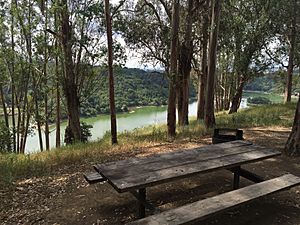Anthony Chabot Regional Park facts for kids
Quick facts for kids Anthony Chabot Regional Park |
|
|---|---|
 |
|
| Lua error in Module:Location_map at line 420: attempt to index field 'wikibase' (a nil value). | |
| Location | Oakland, California |
| Area | 5,067 acres (2,051 ha) |
| Created | 1952 |
| Operated by | East Bay Regional Park District |
Anthony Chabot Regional Park is a large park in Oakland, Alameda County, California. It is managed by the East Bay Regional Park District. The park covers about 5,067 acres, which is like 3,800 football fields! It sits in the San Leandro Hills next to Oakland, San Leandro, and Castro Valley. People love to visit for hiking, biking, and horseback riding. A target practice area, run by the Chabot Gun Club, closed in 2016 due to environmental concerns.
The park's land is often hilly. You will find open grasslands, thick chaparral bushes, and tall eucalyptus trees.
Fun Things to Do
Anthony Chabot Regional Park is connected to other parks like Lake Chabot Regional Park and Redwood Regional Park. This means you can find many trails for different activities.
Trails for Adventure
You can enjoy hiking, horseback riding, and cycling on the park's trails. These trails also link up with paths in nearby regional parks. You can find places to start your adventure along Redwood Road and Skyline Boulevard in Oakland.
Horseback Riding
The park has two special centers for horses. These are the Chabot Equestrian Center and Skyline Ranch Equestrian Center. Here, people can keep their horses or take riding lessons.
Past Activities
A place for target practice was once in the park. It was run by the Chabot Gun Club. This area closed in 2016 after 53 years. It was shut down because of pollution from shell casings.
Nearby Fun at Lake Chabot
Right next to Anthony Chabot Park is Lake Chabot Regional Park. At the lake, you can find a public golf course called Redwood Canyon. There is also a marina where you can rent boats. Many picnic areas are available for families and friends to gather.
Camping Adventures
Camping is a very popular activity here. The park has a family campground with 75 spots. It also has seven group camps for larger gatherings.
Family Campground
The Anthony Chabot Family Campground is open all year. It has 53 campsites where you can drive your car right up to your tent. There are also 10 walk-in tent sites and 12 spots for RVs or trailers. Some campsites offer beautiful views overlooking Lake Chabot.
Group Camps
The park's seven group campsites are perfect for bigger groups. They can hold anywhere from 11 to 300 campers. Bort Meadow Group Camp is one of these. It can hold up to 300 people and even allows campers with horses.
Park History
Anthony Chabot Regional Park first opened in 1952. It was originally called Grass Valley Regional Park. This name came from the Grass Valley area in the northern part of the park. In 1965, the park was renamed to honor Anthony Chabot. He was important because he built Lake Chabot and Oakland's first public water system.
Early Inhabitants and Land
The land that makes up the park was once home to the Jalquin people. They were part of the Ohlone and Bay Miwok tribes. In the 1840s, the land was divided by Mexican land grants. The southern part went to Rancho San Lorenzo, and the northern part went to Rancho San Antonio. In the 1860s, American settlers started ranching here. This included the 525-acre Grass Valley Ranch, which is now Bort Meadow. Cows still graze in Grass Valley today.
Redwood Trees and Eucalyptus Plantations
Many coast redwood trees were cut down in Anthony Chabot Regional Park and nearby Redwood Regional Park. This happened from the late 1800s to the early 1900s. All the original redwood trees in Anthony Chabot Park were logged. However, many new trees have grown back and are now over 100 years old.
Around 1910, water companies started planting many eucalyptus trees. These trees are still a big part of the park's landscape today.
The Marciel Family
Some of the water company land was rented to ranchers in the 1900s. One family was the Maciel family, who came from the Azores. They ranched the land where the Anthony Chabot Family Campground and the target practice area are now. Their family name was later changed to Marciel because of a mistake in a school record. The main road to these areas is called Marciel Road, named in their honor.
Big Bear Tavern and Jazz
Near the Big Bear Staging Area on Redwood Road, there used to be a place called the Big Bear Tavern. Nothing is left of it today. But this spot was famous for starting the traditional jazz revival. In 1940, Lu Watters formed the Yerba Buena Jazz Band here. They wanted to play a different kind of music than the popular big band music of that time. Jam sessions were often held at the Big Bear Tavern. Up to 400 people would gather to dance. The band even wrote a song called "Big Bear Stomp" to remember the tavern.
Other Past Features
In the past, the park also had a ropes course, an archery range, and a motorcycle park.
Closure of the Target Practice Area
On March 1, 2016, the East Bay Regional Park District Board of Directors voted to close the target practice area. This area had been open since 1963. It stopped operating on September 5, 2016.
Movies Filmed Here
A film set for a service station was built along Redwood Road at the Big Bear Staging Area. This was for a car chase scene in Clint Eastwood's movie True Crime (1999).
See also
 In Spanish: Parque regional Anthony Chabot para niños
In Spanish: Parque regional Anthony Chabot para niños


